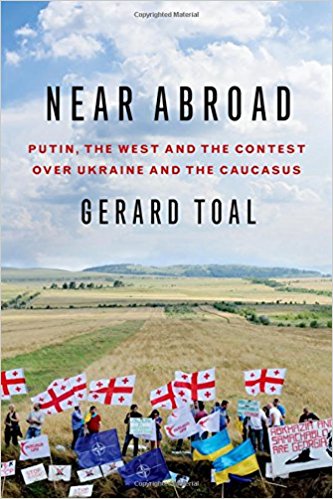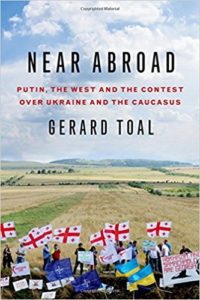

This is part of our special feature, Diversity, Security, Mobility: Challenges for Eastern Europe.
This is first of all a book about the Georgia war in 2008 and the Russian military aggression against Ukraine. The latter started with the annexation of Crimea in spring 2014, and continued with the Russian military participation in a rebellion against Kiev in Donbas. A detailed analysis of these events, both in terms of what happened and why they happened, constitutes the main body of text. In this reviewer’s mind, Toal’s account is among the best analyses of both these events currently available in English. Toal is especially good at distinguishing between understanding Russian behavior and accepting it.
The author himself explicitly states that the book is written first and foremost for the general audience. It will indeed function very well for that audience. Not only is the analysis balanced and well researched, it is also something of a page-turner. That is far from always the case with scholarly studies.
Toal starts by explaining the crucial importance to Russia of the post-Soviet area both in terms of interests, ideas and emotions. He then gives a detailed account of the Russia-Georgia conflict, and traces its origin back to the days of nationalist leader Zviad Gamsakhurdia in the early 1990s. The account is especially valuable in detailing the developments in the period immediately prior to the outbreak of war. In addition, he also gives a thorough account of the war itself.
After dealing with the Georgia case, the author presents a similar review of the Russia-Ukraine conflict. Here, however, there is slightly less focus on chronological development. More attention is given to public sentiment in Ukraine. Popular opinion in Ukraine on issues of language, culture, and attitudes towards Russia plays a central role here. A major point for Toal is to demonstrate that to be a Russian speaker in Ukraine in no way implies that you are necessarily also pro-Russian.
Since the annexation of Crimea and the start of hostilities in Donbas, several have argued that we should have seen this coming. The signs were there for all to see for a long time. Toal, on the other hand, thinks that “the road from the Maidan to the annexation of Crimea, the pathway to crisis and Russian interventionism, was not predestined” (209). Most conflicts have both predisposing and activating causes. Toal is especially good at detailing the latter. He also underscores that the Russian leadership probably had more than one type of acceptable outcome to the conflicts in mind when they decided to use force.
The book also has a purpose beyond telling the stories of how and why these conflicts took place. Toal thinks that the US debate about these conflicts has been far too simplistic. He sees the debate as based either on a very principled condemnation of what is seen as Russia’s unacceptable imperialism, or on realist convictions about how any great power would behave. According to Toal, a major reason for this simplistic debate is that scholars and politicians from both camps tend to start from preconfigured ideas about how reality looks rather than from the empirical details of each conflict. He here introduces the concepts of thick and thin geopolitics. The first is based on robust empirical knowledge, the second on very general ideas. Toal is probably here expressing a sentiment that many Russia and post-Soviet area experts have felt since Russia again became daily frontline news. In times when Russia was given less attention, fewer people commented on Russian affairs and area experts contributed a larger proportion of the commentary. Now, with Russia much higher on the international agenda, many more people comment on Russian affairs. This fact by necessity also leads to more commentary from people with limited empirical knowledge of the region, and that sometimes leads to frustration among area-specialists.
Toal’s criticism is mostly directed at the US debate. He only very briefly discusses the European one. That being the case, he could probably have been clearer in stating that his conclusions are true first and foremost for the US. For example, the idea of Ukraine as a geopolitical prize (204) to be fought over with Russia may have been prominent in the USA, but for many European countries that was never the case. In the 1990s and much of the 2000s many European countries saw Ukraine mostly as a problem, and certainly not as a prize. In terms of membership in the EU and NATO it was much more a question of keeping Ukraine at an arm’s length than of helping the country to enter. It is true, however, that this state of affairs changed significantly as a result of Russia getting more and more authoritarian, the Georgia war, and most importantly the entry of Poland and the Baltic countries into the EU and NATO. The criticism of the US debate, however, seems well argued.
The main body of analysis in the book is empirical. However, theory is not absent. Toal himself writes that the analysis is “mindful of theory.” This is a vague statement, and the role of theory throughout the book is correspondingly unclear. Some theoretical concepts are presented in the introduction, first of all critical geopolitics, but they are largely absent from the main body of analysis, and they only partly reappear in the conclusion. Thus, it appears that the presence of theory neither significantly aids the reader’s understanding of the conflicts under investigation, nor that the conflicts themselves are case studies or a larger universe that can bring new insights to theory.
The book’s emphasis on the need to understand, to the extent possible, the mental world of Kremlin decision makers is commendable. Toal makes very clear that this understanding in no way is the same as justification. However, a too strong emphasis on “world view analysis” may lead to an underestimation of instrumental calculation. For example, there are reasons to believe that Russian leaders genuinely believe that the Georgian Rose Revolution and the Ukrainian Euromaidan were coups inspired by the West, and that this belief guides their policy. On the other hand, there is little reason to think they actually believe that Kiev after Euromaidan has been ruled by a fascist junta. Thus, some stated Russian motives will reflect genuine beliefs whereas others will be lies or half-truths used for instrumental reasons. Toal does not really discuss this issue on a systemic basis, but in the empirical part of the analysis both types of motivation are present.
As stated above, the chapters that deal specifically with the development of the two conflicts are convincing reading. Still, a few comments are also warranted here. Some statements seem unnecessarily blunt or opinionated. For example, Boris Yeltsin is written off as a “naïve and deeply flawed populist” (69), and the annexation of Crimea is without reservation said to be a “strategic blunder” (281). Both are controversial statements that would have benefitted from being less categorical. The examination of the results of the Georgian Rose Revolution may also appear relatively harsh. There is much focus on the democratic regression under Shakashvili, and much less on the relatively successful economic and administerial reforms engineered first and foremost by Kakha Bendukidze. Finally, the closing part of the conclusion rather surprisingly is neither about Russia nor about the post-Soviet space. Instead, Toal lists a large number of international problems such as climate change, xenophobia, global pandemics and others. This may have been done to place the analyzed conflicts within a larger picture, but instead it appears like a total departure from the rest of the book. These, however, are minor things. For those who would like to read an engagingly written, well researched and balanced account of two of the most discussed military conflicts in recent times, Gerard Toal’s book is an excellent choice.
Reviewed by Tor Bukkvoll, Forsvarets forskningsinstitutt
Near Abroad: Putin, the West, and the Contest over Ukraine and the Caucasus
by Gerard Toal
Publisher: Oxford University Press
Hardcover / 408 pages / 2017
ISBN: 9780190253301
To read more book reviews, please click here.
Published on December 6, 2017.




